3 Apr 2025 | Europe and Central Asia, Middle East and North Africa, News and features, Syria, Turkey
At 2.30pm on 19 December 2024, Ahmed Mohamed, editor-in-chief of the Syrian-Kurdish Hawar News Agency (ANHA), received a dispatch from two of his colleagues. An hour later, they were dead.
“They had just sent me a message saying ‘we’re coming back’,” Mohamed told Index.
Cihan Bilgin and Nazim Daştan, two Kurdish reporters, were reportedly targeted and killed by a Turkish airstrike as they returned from the Tishreen Dam near Aleppo, where they were covering ongoing clashes between the Kurdish-led Syrian Democratic Forces (SDF) and the Turkish-backed network of militias known as the Syrian National Army (SNA).
Indeed, Turkey, which is violently opposed to the Kurdish-led project due to its own domestic repression of the Kurdish cause, continues to target the region and journalists in particular, profiting from the chaos caused by the fall of former Syrian president, Bashar al-Assad. According to the Kurdish-run Firat News Agency (ANF), Turkey has killed 14 journalists and wounded seven others in the Iraqi Kurdistan and Syrian Kurdistan (Rojava) regions since 2019.
Journalists under attack
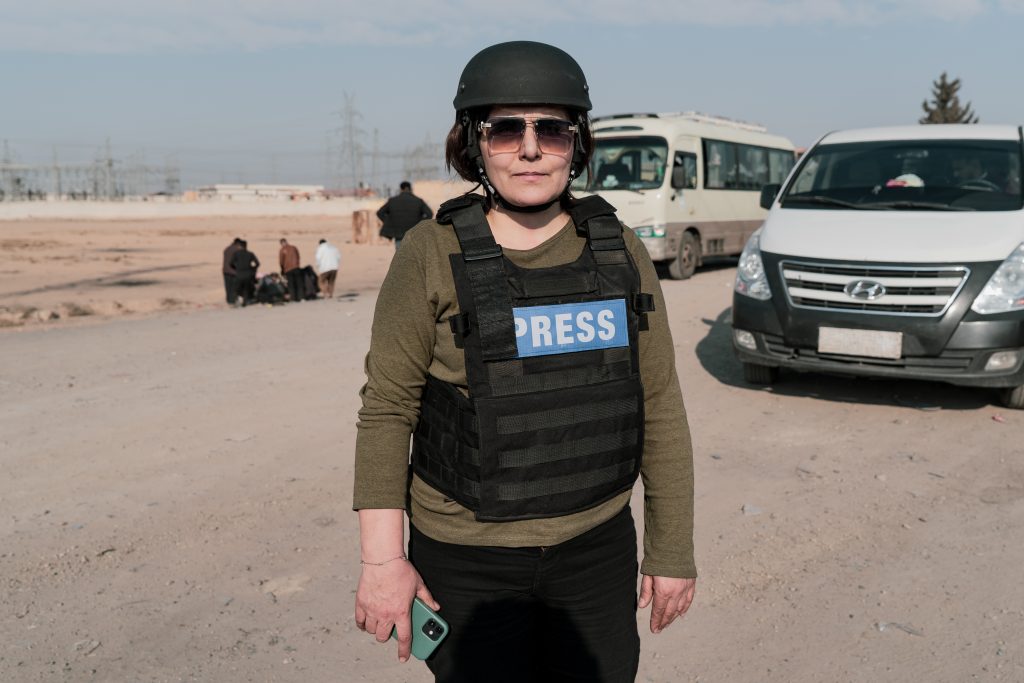
Sinem Adali, a journalist for Rojava TV, is preparing to go to the Tishreen dam front. Photo by Angeline Desdevises / Hans Lucas
In ANHA’s editorial offices in Qamishli, the de-facto Syrian Kurdish capital, a memorial showcases the microphones and cameras of journalists who died in the line of duty. Since 2017, six of ANHA’s journalists have been killed in the field: three reportedly in Turkish attacks, and three while covering the Kurds’ famous fight against the Islamic State of Iraq and the Levant (ISIL).
Despite the recent ceasefire agreement between Syria’s new Turkish-linked president Ahmed al-Sharaa and SDF commander Mazloum Abdi, Turkish bombardments continue to target the Tishreen Dam, according to local monitor Rojava Information Center.
Leyla Abdi, a reporter for Ronahi TV, was wounded at the dam in January. Three days after her arrival at the dam, she was standing alongside civilians staging a protest on the crucial infrastructure, when she was hit by a bombardment. “That day, a dozen drones flew over us all day long. Turkey systematically strikes civilian convoys,” said Abdi, who is still recovering from her injuries.
Kurdish journalists aren’t only targeted when working on the frontline. Repeated attacks have made the road along the Turkish border dangerous, if not impassable. It was here that, in August 2023, the vehicle of the women’s television channel Jin TV was destroyed. The driver, Necimedîn Sînan, was killed instantly, while journalist Delila Ağît lost an arm. Dijwar Iso, who also works at ANHA, said that press workers are now obliged to switch off their phones during missions to prevent the Turkish armed forces on the other side of the border from being able to track and target them.
These attacks are part of a wider drive to stifle the press from covering Turkey’s occupation of North and East Syria, which has killed hundreds and displaced hundreds of thousands of primarily Kurdish civilians to date. In November 2022, journalist Essam Abdallah was killed and another journalist Mohammad Al Jarada was injured in separate Turkish air raids on the same day.
In 2019, a civilian convoy accompanied by Kurdish journalists and a French television team was bombed by Turkish forces, killing two local journalists and injuring others. Several civilians were also killed in the strike.
Although journalists are protected by international law, Turkish president Recep Tayyip Erdoğan’s administration is stepping up its attacks on journalists beyond its borders. In neighbouring Iraq, a drone strike in August last year killed two Kurdish media workers working for a local TV channel and wounded their colleague. Local sources say the drone was operated by the Turkish armed forces, which the Turkish defence ministry has denied. Human rights organisations and Kurdish media unions have called on the United Nations to investigate attacks on journalists, which they describe as “war crimes”.
Gypsy Guillén Kaiser, director of advocacy and communications at the Committee to Protect Journalists (CPJ) in New York, drew attention to the recent murder of Cihan Bilgin and Nazim Daştan, calling on the Turkish authorities to conduct a thorough investigation.
Psychological warfare
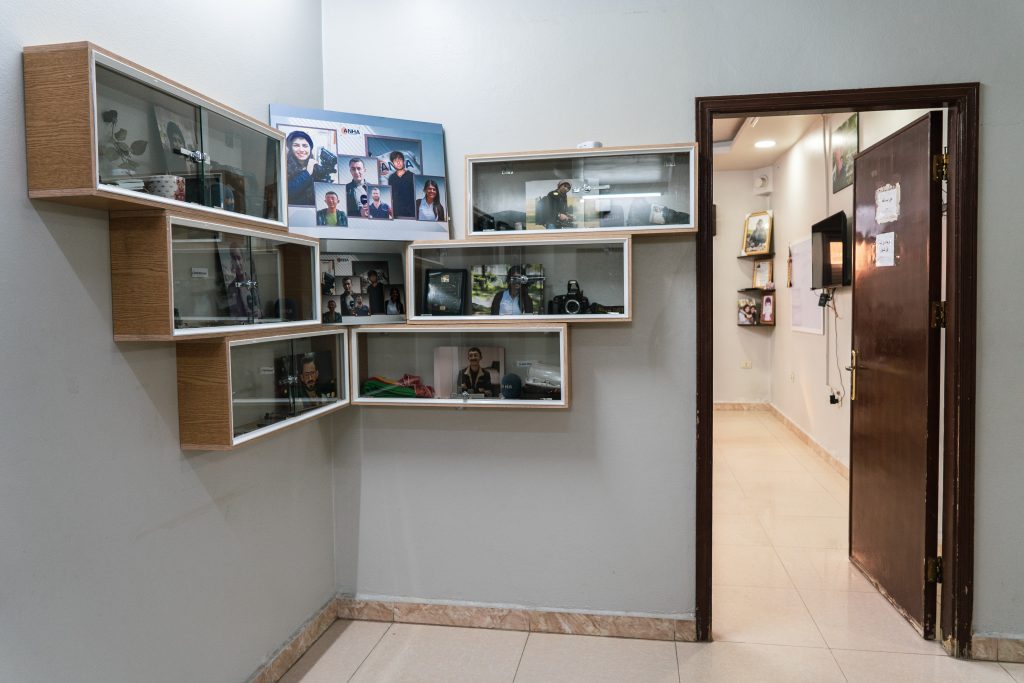
In ANHA’s offices, a memorial showcase displays the equipment and photos of six journalists who died while doing their job in north-eastern Syria. Photo by Angeline Desdevises / Hans Lucas
These constant attacks have created a climate of insecurity for all journalists in the region. Local journalist Loristan Derwish said: “As a woman, it was already hard to obtain the legitimacy to practise our profession and now we are confronted with attacks from Turkey and online harassment.” At the end of 2024, she was subjected to a wave of online harassment following a TV report she made interviewing female Kurdish fighters. Several Instagram accounts impersonating her were created, displaying fake pornographic photo montages. She believes the culprits are in Turkey.
Online harassment is predominantly aimed at female journalists. Arîn Swed, spokesperson for the Syrian Kurdish Women’s Media Union (YRJ), said the union defends all female media workers against sexist and psychological attacks. “We supported Cîhan when she was threatened over the phone by MIT [Milli İstihbarat Teşkilatı – the Turkish secret service],” she said.
As of today, it is believed that at least five journalists, including Ciwana Cuma, a reporter for Ronahî TV, are being targeted. Cuma has covered the confrontations at the Tishreen Dam on several occasions. In a post on X (which has since been deleted) made by a Turkish account with more than 200,000 followers, the young woman was described as “another example like Cihan Bilgin”, “a terrorist”, and therefore identified as a potential future target.
The dehumanisation of journalists continues after their death. According to multiple sources, a photo of the decapitated body of reporter Vedat Erdemci, who was killed in a Turkish airstrike in 2019 in the Syrian city of Ras al-Ain, was sent to his mother. The Turkish state also refused to allow Cihan Bilgin and Nazim Daştan’s bodies to be handed over to their families in Turkey. They were finally buried in Qamishlo in January.
The West’s failure to respond to these crimes also creates negative psychological outcomes, local press workers say. “The death of a Kurdish journalist doesn’t cause a stir. The West creates a hierarchy among lives,” said Berîtan Ali, the regional head of a Kurdish TV station. Dilyar Cizîrî, co-chair of Free Press Union (YRA) organising in north-east Syria echoed her words: “Turkey’s attacks benefit from a sense of impunity, [caused] by the silence of international institutions.”
Destroying material resources
Beyond psychological attacks and online harassment, one of Turkey’s objectives is to shut down all means of expression for journalists in north and east Syria. Their social media accounts are frequently closed down by the platforms and their websites hacked. The ANHA website is the victim of roughly 7,000 cyber attacks per day, according to editor Mohamed. In 2019, hackers succeeded in replacing the homepage with a Turkish nationalist message, he said. Radio frequencies are also hijacked, the editor added, and overlaid with Turkish nationalist propaganda.
The media also face difficulties in obtaining the equipment they need to do their job, due to an embargo imposed on the region. “It is impossible to transport professional equipment legally across the Iraqi border. We have to find other ways,” said Mohamed. The workers are therefore forced to smuggle in protective equipment, such as bulletproof vests and helmets. ANHA only owns five vests for a team of 61 journalists, he said.
Fleeing domestic repression
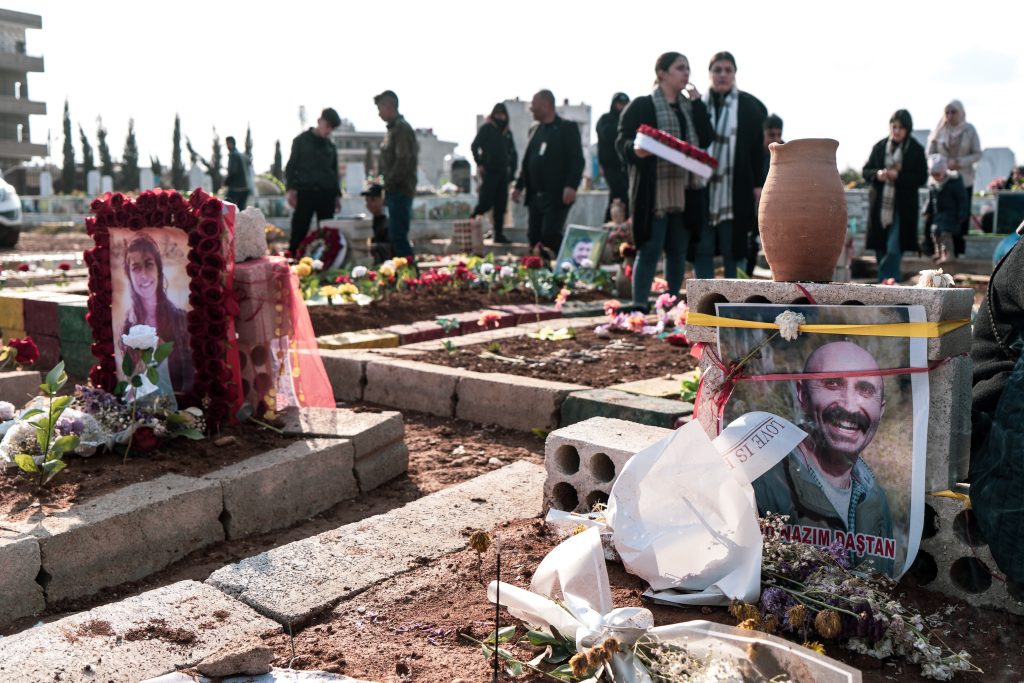
The bodies of the two Kurdish journalists Cihan Bilgin and Nazim Daştan are buried in Qamishli. Photo by Angeline Desdevises / Hans Lucas
In Turkey, attacks on opposition journalists have forced many into exile. Threatened with imprisonment for covering a demonstration near the Syrian border, Turkish-Kurdish journalist Dilan Dilok had to flee Turkey for Syria in 2017. “If I return to Turkey, I will either be arrested or killed,” she said. She adds that Turkish police are trying to intimidate her again: “My parents are often raided in the middle of the night and subjected to long interrogations.”
Bazid Erven, a reporter for Kurdish news agency Ajansa Welat, and 10 other journalists were allegedly arrested on 20 December 2024 in Van, Turkey, for protesting against the assassination of their colleagues. “These arrests are nothing new, they are routine for us,” Erven said. The day after his own arrest, seven other journalists were detained in Istanbul for several weeks. “There is state and police repression against Kurdish journalists,” he added. It therefore comes as no surprise that Turkey is ranked 158 out of 180 countries in Reporters Without Borders’ worldwide press freedom ranking.
A future for the Syrian press
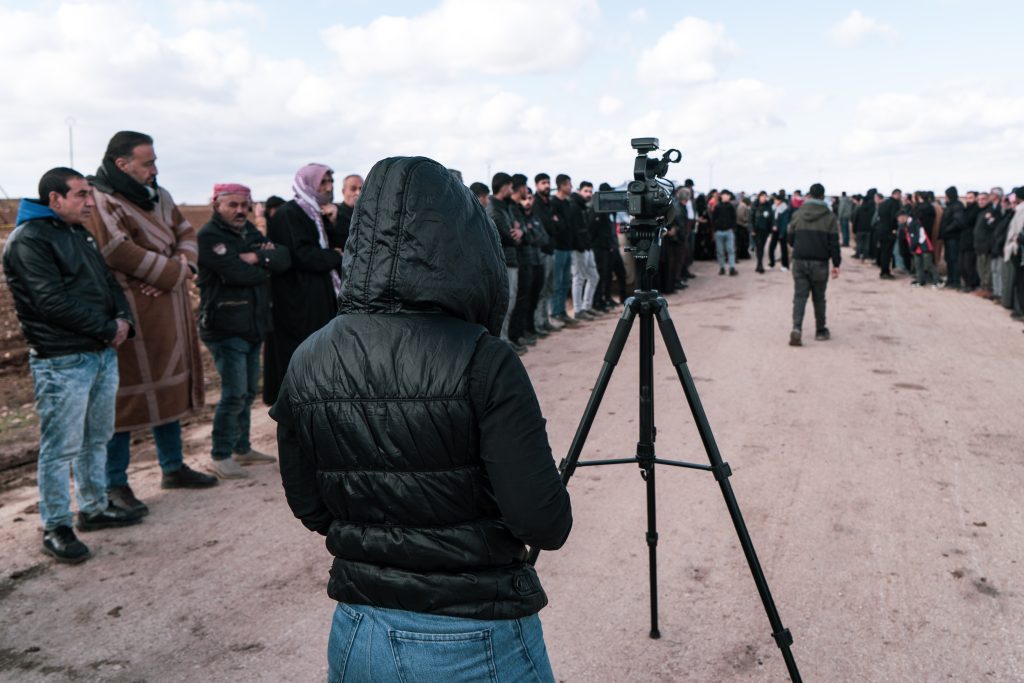
A Jin TV journalist reports on the funeral of two Kurdish political figures killed by a Turkish drone strike in Iraq. Photo by Angeline Desdevises / Hans Lucas
Since the fall of Assad’s regime, the ANHA agency has opened several offices across Syria. Its journalists, who previously worked underground in other regions of the country, can now operate openly. However, there is still concern for Syrian news professionals in view of the rampant insecurity in the country, a reality brought home by recent massacres committed by forces of the new government, targeting the Alawite minority.
On 6 February, interim prime minister Mohammed al-Bashir ordered the dissolution of the Syrian Journalists‘ Union (SJU). The Free Press Union (YRA)’s Cizîrî strongly condemned this decision: “The SJU was controlled by the former regime, but the solution should have been to restructure it.” The International Federation of Journalists also sent a letter to Al-Bashir and Syrian president Al-Sharaa, condemning the dissolution of the union and calling on them to uphold international law.
North and East Syria’s YRA says it is ready to help establish a new nationwide independent union and has just set up a Security Advisory and Risk Management Unit in order to provide “support and assistance to all Syrian journalists and media workers”. It seeks to pressure armed groups so that they abide by international law and wants to “contribute to efforts toward accountability and justice”.
In Qamishlo, the latter are yet to be found. Women’s Media Union (YRJ) president Swed is moved when she talks about her colleagues who have been killed in the field. But above all, she is determined to fight for their legacy: “As soon as [Cihan’s death] was announced, the women of the union took over. Today, if ANHA’s media coverage of Tishreen continues, it is thanks to the other women journalists.”
8 Feb 2023 | Iran, Iraq, News and features, Syria, Turkey
The murder of a 22-year-old Kurdish woman in Iran by the Gasht-e-Ershad ‘guidance patrols’ in September sparked protests worldwide. Celebrities cut off their hair and chanted ‘Women, Life, Freedom’ in support of the movement born out of her funeral. But ‘Mahsa Amini’ – as she is identified by the mainstream press – is a misnomer.
“Her formal name according to the Iranian state is Mahsa, but she was known as Mahsa only by the authorities,” British-Kurdish writer and organiser Elif Sarican told Index. “She was known as Jina to her family, friends and everyone that knew her. It’s what is on her gravestone.”
Sarican described the deliberate misnaming of Kurds as a tactic to deny their existence. The insistence on calling Jina the wrong name is “painful” she said, particularly when it’s by the mainstream media.
“It’s very difficult in Iran – not impossible – but very difficult, to have a Kurdish name,” she explained. “The Iranian state is very specific about the kind of Iran it envisages. Unfortunately, similarly to other parts of Kurdistan, Kurdish people cannot name their children with Kurdish names.”
In 1990, Sarican and her family migrated to London from Maraş in north Kurdistan, the site of one of the largest Kurdish massacres in contemporary Turkey. It was aimed at people just like her family – Kurdish Alevis.
The unrest in Iran, Sarican says, is representative of a universal Kurdish experience. It’s an uprising of people that have been denied for 100 years.
“‘Women, Life Freedom’, or ‘Jin, Jîyan, Azadî’ in Kurdish, comes from the Kurdish Women’s Movement,” she continued. “It’s a part of the Kurdish Freedom Movement founded by the imprisoned Abdullah Öcalan.”
Since the news of Jina Amini’s murder broke, the slogan has been adopted internationally as a symbol of solidarity. But the phrase, Sarican tells me, has been dissociated from its radical, political origins. It exists as a result of decades of struggle for women’s liberation and marked a big shift in the Kurdish Freedom Movement when women’s liberation was adopted and cemented as a core pillar.
“Bringing together women, life and freedom is what the Kurdish Freedom Movement ideology is. It’s based on radical democracy, ecology and women’s liberation. All of these coming together is the only way to achieve freedom.”
It’s no surprise, she explains, that Iranian protesters took inspiration and borrowed this slogan from their brothers and sisters in other parts of Kurdistan. “This is an expression of universal Kurdish struggle.”
The persecution of Kurds persists across the region. “100 years ago – and this year is the 100-year anniversary of the Treaty of Lozan – the Kurdish regions were divided into four nation states: Turkey, Syria, Iraq and Iran. As a result of that, the experience of Kurdish people has been denied,” Sarican explained.
Kurdish language, culture and political expression are suppressed across the region. Fundamentally, they are denied the right to exist, she says. In Turkey, in the last 10 years, many Kurdish activists, elected MPs, mayors and councillors have been imprisoned. Although the Kurdish language is no longer formally banned in Turkey, it is repressed.
“To have education in your mother tongue is an international human right,” she explains. This is not a right granted to Kurds in Turkey.
While the treatment of Kurds in Iran, Syria and Iraq is brutal, Sarican says, it is limited to their own borders. Turkey not only oppresses Kurds in its own borders, but has invaded Syria, and continues to build military bases in northern Iraq.
“They are interfering in the lives of Kurdish people in at least three areas of Kurdistan. When the protests were happening in Iran and there was solidarity being shown in parts of Turkey, the police brutally cracked down on these demonstrations.”
Mournfully, she tells me that this month is the 10-year anniversary of the assassination of three Kurdish women by Turkish intelligence in Paris. In a disturbing mark of the anniversary, three more activists were assassinated in the same location just a few weeks ago.
“The Kurdish people are feeling unsafe not only in most parts of Kurdistan, but also in other parts of Europe,” Sarican continued.
Kurdish people constitute 10% of Iran’s population but make up about 50% of their political prisoner numbers. Many prisoners are denied proper health access, the most basic human rights, proper visits with family and connection with the outside world. Sadly, she says, many European states also extend these policies against Kurdish people in Europe.
“Kurdish communities are some of the most politically organised. The Kurdish freedom movement is not only one of the biggest political movements in the Middle East right now it is actually one of the largest social movements in Europe as well. [Criminalisation of our communities] really curtails and impacts the organising and protests.”
“Staying in tune with what’s happening in Kurdistan is of the utmost importance. It’s important that any future, whether it’s in Turkey or Iran – because it’s all connected, very very closely – is a future that works for the people. That’s a future of radical democracy, of ecology and of women’s liberation. Because otherwise these theocratic dictatorships will cement themselves.”
She stressed the significance of understanding the political projects that are already in existence across Kurdistan, instead of trying to impose a Western solution. “My call would be for people to understand the Kurdish Freedom Movement programme and what it’s offering. Read the memoir of Kurdish revolutionary Sakine Cansiz. Read the works of Abdullah Öcalan. Understand what the political project is and how we can work together to realise it. [The crisis in the Middle East] will only result in an actual, meaningful freedom if there is a political vision, led by the Kurdish freedom movement. It’s time we support that movement and come together to make sure that that is what the future of Kurdistan looks like.”
22 Sep 2022 | Iran, News and features
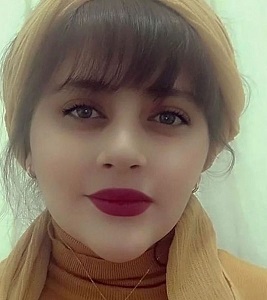 Iranians are again finding it impossible to access the internet and social media messaging platforms after yet another shutdown by the country’s authorities. The move comes after protests erupted in the country, sparked by the death of 22-year-old Mahsa Amini (right) last Friday.
Iranians are again finding it impossible to access the internet and social media messaging platforms after yet another shutdown by the country’s authorities. The move comes after protests erupted in the country, sparked by the death of 22-year-old Mahsa Amini (right) last Friday.
Critics say the shutdown of services and the filtering of content is restricting freedom of expression and preventing peaceful protest. Access to news in Iran is strictly controlled by the government and for many Iranians, their only access to independent news sources is through digital platforms.
Amini, a Kurdish woman from Saggez in Iranian Kurdistan, was visiting relatives in Tehran on 13 September when she was arrested by the Gasht-e Ershad. These so-called “morality police” uphold respect for Islamic morals, including detaining women who they see as being improperly dressed, such as wearing revealing or tight-fitting clothing or not wearing the required hijab.
The morality police detained Amini as she and her brother were coming out of the city’s Haqqani metro station. Eyewitnesses said Amini was brutally assaulted by the agents inside their vehicle and then taken to a police station.
Two hours after her arrest, Amini went into a coma. She was then taken to Kasra Hospital where doctors said she had suffered a heart stroke and brain haemorrhage due to a fractured skull. She died on Friday, 16 September.
Ever since her death, protests have spread across the country, reaching more than 80 cities nationwide. In typical fashion, the authorities have responded by shutting down access to the internet in a bid to quell the protests.
Iran is one of the world’s biggest censors of the internet. The country has been concerned about the internet since the turn of the millennium and has been operating a sophisticated system of hardware and software-based content filtering ever since. A broad project now known as the National Information Network (NIN), and similar to China’s Great Firewall, was launched in 2005. It requires companies to use Iranian data centres and forces internet users to register using their social IDs and telephone numbers.
NIN was finally fully implemented in 2019 and that same year Iran’s Supreme Leader Ayatollah Ali Khamenei said of the internet, “During these past 40 years, and today as ever, the enemy’s propaganda and communication policy, as well as its most active programmes, have revolved around making people and even our officials and statesmen lose their hope in the future. False news, biased analysis, reversing facts, concealing the hopeful aspects, amplifying small problems and berating or denying great advantages, have been constantly on the agenda of thousands of audio-visual and internet-based media by the enemies of the Iranian people.”
The country also has a history of using internet shutdowns to crack down on dissent.
In 2019, protests broke out across the country when the Iranian government announced a 50 per cent increase in fuel prices and monthly rationing of petrol. More than 100 people died, according to reports. The government swiftly shut down the internet and mobile networks for several days.
In February 2021, at least ten fuel couriers in Sistan and Baluchistan province on the border with Pakistan were killed after a two-day stand-off triggered by the Islamic Revolutionary Guard Corps blocking the road to the city of Saravan. The killings triggered demonstrations, leading to further deaths, and the regime shut down the internet across several cities in the province.
The UN High Commissioner for Human Rights said at the time: “Blanket internet shutdowns violate the principles of necessity and proportionality applicable to restrictions of freedom of expression and constitute a violation of international human rights law.”
The protests around the death of Mahsa Amini have seen the Iranian authorities reach for the internet shutdown playbook once more.
NetBlocks and AccessNow report that internet access began to be disrupted in Tehran and other parts of the country on the day of Amini’s death and on Monday 19 September, internet access was shut down almost totally in parts of the Kurdistan province.
The KeepItOn coalition, of which AccessNow is a member, said that this represents Iran’s third internet shutdown in less than 12 months. They said the “repressive, knee-jerk response to recent protests seriously interferes with people’s right to freedom of expression and assembly”.
Iranians have increasingly resorted to using unfiltered channels to get their news, as the only parts of the internet that they can access are censored. By 2018, it was believed that more than half of Iran’s population were using Telegram. In April that year the judiciary banned the popular messaging app, claiming it has been used to organise attacks and street protests. Since then, Iranians have switched to WhatsApp and Instagram.
It comes as no surprise that with the current protests NetBlocks has reported that access to Instagram, one of the last remaining social media platforms in Iran, was restricted across all major internet providers on Wednesday 21 September.
The authorities appear to have clamped down because of the widespread nature of the protests and, perhaps more worryingly for the regime, a large number of video clips that have gone viral and which they are keen to suppress.
A peaceful protest in Saqqez
Not just the young
A clip of several men defending a woman who has removed her hijab
Another video clip shared on Twitter by British comedian Omid Djalili, whose parents are Iranian, suggested that, perhaps, attitudes may finally be changing in Iran.
Responding to the crackdown on protest and the internet shutdowns, experts from the UN Human Rights Council’s Special Procedures group said in a statement, “Disruptions to the internet are usually part of a larger effort to stifle the free expression and association of the Iranian population, and to curtail ongoing protests. State-mandated internet disruptions cannot be justified under any circumstances.”
“Over the past four decades, Iranian women have continued to peacefully protest against the compulsory hijab rules and the violations of their fundamental human rights,” the experts said. “Iran must repeal all legislation and policies that discriminate on the grounds of sex and gender, in line with international human rights standards.”
Speaking to Index, exiled Iranian film-maker Vahid Zarezdeh said the WhatsApp and Instagram ban means he has been cut off from his young son and the rest of his family still in the country.
He said, “In the absence of independent parties and free media, Iranian society gets its news and events, social and political issues from the internet. News reaches its audience very quickly and people can easily distinguish fake news from real news. How, you ask? The solution is very easy. By looking at the state television, you can understand which news is true and which is false. Whenever the government reacts sharply to news and prepares a report, it is very likely that the news is true, and when it ignores the news and is indifferent, it means that it is fake.”
State TV has been reporting on the protests but its coverage has focused less on the protests by women and instead suggesting that the unrest has been caused by Iran’s enemies, rather than spurred on by the regime’s crackdown. Certainly, TV viewers in the country have not seen the clips above.
“This is a system of repression and the Iranian regime does not care what the world community thinks about it and human rights,” said Zarezdeh.
He added, “It’s more than forty years since Iranian women started to be ignored by the Islamic regime. Now they have found the courage and belief to stand in front of the bullets with empty hands and without a scarf.
16 May 2022 | Awards, Cuba, Fellowship, Fellowship 2022, Palestine, Turkey, Yemen
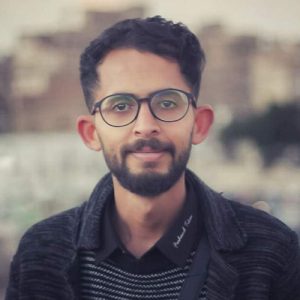 Yemeni artist Thiyazen Al-Alawi uses his craft to shed light on the destructive situation in Yemen through street art campaigns. He hopes to inform the public of what the war has done to his homeland.
Yemeni artist Thiyazen Al-Alawi uses his craft to shed light on the destructive situation in Yemen through street art campaigns. He hopes to inform the public of what the war has done to his homeland.
First inspired by the Arab Spring in 2011 as a teenager, Thiyazen turned to art as a form of self expression, launching his first street art campaign in 2012 as the war began. As conflict invaded every aspect of Yemeni life, he decided “every artwork is proof of their existence and continuity in life…something that gives people hope.” Thiyazen’s work aims to reflect the ugliest and truest forms of war, and its effect on real people.
Thiyazen’s latest project is a collaboration with British artist Luc Waring titled “Letters from Yemen”, a series of drawings and letters from conversations between the two about art, peace, war, and the horrors Thiyazen has witnessed himself. Inspired by a saying Thiyazen heard in his youth, the walls must do the talking when the newspapers are silent; the compiled writings and portraits raise awareness about the war in Yemen with a sensitivity and humanity only an artist and their medium can produce, eventually gaining traction and attention by the public. Due to the ongoing occupation by the Houthi militia, Thiyazen is risking his own safety as he continues to produce art.
Thiyazen continues his work on long-term projects with the Swiss Arts Council to spread awareness about the conditions in Yemen. He also contributes to the “Yemen Peace Forum” with the Sana’a Center for Strategic Studies, writing articles and studies like “Art and Youth in Yemen” in the Journal of Transitional Justice of the University of Oxford. “I feel that I must tell the truth no matter what,” Thiyazen explains,” I could sacrifice my life for the truth. And nothing will stop me.”
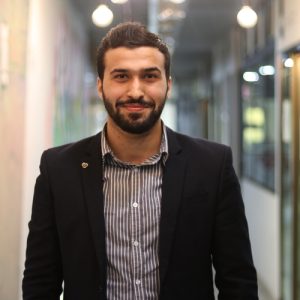 Moe Moussa is a journalist, podcaster, poet, and the founder of the Gaza Poet Society. He uses various forums and mediums to amplify the voices of Palestinians.
Moe Moussa is a journalist, podcaster, poet, and the founder of the Gaza Poet Society. He uses various forums and mediums to amplify the voices of Palestinians.
Moe began his career as a translator for international journalists in 2014. He was soon inspired to speak about the situation from his own perspective. Studying English literature in college and growing up around poetry, it was only fitting that Moe decided to use his art to bring the individual lives of people in Gaza to the international audience.
Delving into Palestinian poetry led Moe to connect online with poets all over the world. He was interested in using his skills as a poet and a journalist to share the stories of individual lives with a global audience. After realising the lack of opportunities for poets to share their work in Arabic and English, he created a space to offer an opportunity for young people to speak and find their own voice in 2018 – the Gaza Poet Society. The organisation is supported solely by donations from international poets who believe in Moe’s cause. He is at constant risk of Hamas censorship and at the will of the Gazan government to approve of civilian movement out of the country.
Watching his family go days without water, power, and freedom of movement, Moe temporarily left Gaza for Istanbul in 2021 to continue his work more effectively. He was awarded the Times Richard Beeston Bursary in 2019 and has plans to complete his fellowship in London in 2022 following delays due to the pandemic. As the creator and host of the podcast “Gaza Guy”, he is focused on amplifying the voices of young Palestinians through poetry and fights for access to education in Gaza. Additionally, Moe has contributed to We Are Not Numbers, a site publishing stories of Palestiniain youth experiencing war. Moe recently released his debut poetry collection titled “Flamingo” and is working freelance to support the Gaza Poet Society from abroad.
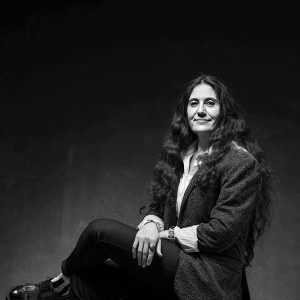 Fatoş İrwen is a Kurdish artist and teacher from Diyarbakır, Turkey working with a variety of materials and techniques.
Fatoş İrwen is a Kurdish artist and teacher from Diyarbakır, Turkey working with a variety of materials and techniques.
İrwen regularly uses her art to document her experiences as a Kurdish woman living in Turkey. The performance piece Füg [Fugue, 2012] documented her first experiences in police custody where she was physically and sexually abused. In 2016 İrwen was again taken into custody while boarding a domestic flight. She was charged with “resisting the police, opposition to the law against demonstrations and assemblies, propaganda for a terrorist organisation, belonging to a terrorist organisation” and sentenced to 3 years, 1 month and 15 days in prison. The charges related to a peaceful protest in 2013.
During her imprisonment, İrwen made 1,500 works of art using materials accessible to her, including hair, tea, food, shoe polish, old textbooks and newspapers, bed sheets, laundry pegs, scarves, and mould and cigarette ashes. Among other projects, the 2019 piece titled “Gülleler” (Cannonballs) features balls crafted from the hair of inmates participating in a hunger strike. “The hunger strike was like firing a shot to the outside world,” İrwen says. After being released, İrwen collected her art pieces in her first solo exhibition titled Exceptional times which was featured at Depo in Istanbul in 2021.
Discussing censorship by the Turkish authorities, İrwen says “this issue still continues to be the most painful issue of our lives and for which we pay a heavy price.” She is deeply committed to fighting for freedom of expression and artistic freedom.
Due to her challenges with Turkish authorities and her identity as a Kurdish woman, İrwen has found that galleries and art spaces are sometimes reluctant to feature her work. Still, she has found success, and her work has been exhibited in Iran, Germany, Austria, Hong Kong, Iceland, France, Mexico, Iran, Morocco, Sweden, and Turkey.
 Hamlet Lavastida has been described as a political activist by way of art. Lavastida uses his art to document human rights abuses in Cuba and to criticise Cuban authorities.
Hamlet Lavastida has been described as a political activist by way of art. Lavastida uses his art to document human rights abuses in Cuba and to criticise Cuban authorities.
Lavastida pushes boundaries of censorship in Cuba and highlights the distinctly Cuban spirit of cultural resistance. His work reconstructs old Cuban political and military propaganda.
Throughout his career, Lavastida has sought to use his art to fight for transparency and freedom of speech in order to fight against the Cuban government. He sees his art as a non-violent tool to fight against the current regime. Lavastida has been involved in various protest movements in Cuba, including the 27N movement which grew out of the protests held on 27 November 2020. The movement works to bring attention to the censorship of artistic expressions in Cuba.
In June 2021, Lavastida was arrested after returning from a residency at the Künstlerhaus Bethanien in Berlin. He was accused of ‘incitement to commit a crime’ because he suggested that other artists stamp images related to the San Isidro and 27N movements on local currency. Following his arrest, Amnesty International named him as a ‘prisoner of conscience’. Lavastida stayed in prison for 87 days. He was finally released without charges.
Lavastida has been living in exile in Europe since September 2021. He has been warned that he will be arrested immediately if he ever tries to return to Cuba. Lavastida is deeply concerned by the situation. While has experienced threats and censorship targeting his art throughout his career, he is now experiencing threats against him as an individual. He believes this is part of a greater trend of censorship in Cuba.
Lavastida plans to continue creating art and speaking up about the situation in Cuba.





 Iranians are again finding it impossible to access the internet and social media messaging platforms after yet another shutdown by the country’s authorities. The move comes after protests erupted in the country, sparked by the death of 22-year-old Mahsa Amini (right) last Friday.
Iranians are again finding it impossible to access the internet and social media messaging platforms after yet another shutdown by the country’s authorities. The move comes after protests erupted in the country, sparked by the death of 22-year-old Mahsa Amini (right) last Friday. Yemeni artist Thiyazen Al-Alawi uses his craft to shed light on the destructive situation in Yemen through street art campaigns. He hopes to inform the public of what the war has done to his homeland.
Yemeni artist Thiyazen Al-Alawi uses his craft to shed light on the destructive situation in Yemen through street art campaigns. He hopes to inform the public of what the war has done to his homeland. Moe Moussa is a journalist, podcaster, poet, and the founder of the Gaza Poet Society. He uses various forums and mediums to amplify the voices of Palestinians.
Moe Moussa is a journalist, podcaster, poet, and the founder of the Gaza Poet Society. He uses various forums and mediums to amplify the voices of Palestinians. Fatoş İrwen is a Kurdish artist and teacher from Diyarbakır, Turkey working with a variety of materials and techniques.
Fatoş İrwen is a Kurdish artist and teacher from Diyarbakır, Turkey working with a variety of materials and techniques. Hamlet Lavastida has been described as a political activist by way of art. Lavastida uses his art to document human rights abuses in Cuba and to criticise Cuban authorities.
Hamlet Lavastida has been described as a political activist by way of art. Lavastida uses his art to document human rights abuses in Cuba and to criticise Cuban authorities.